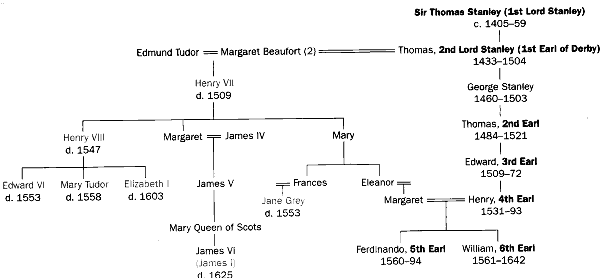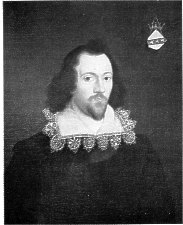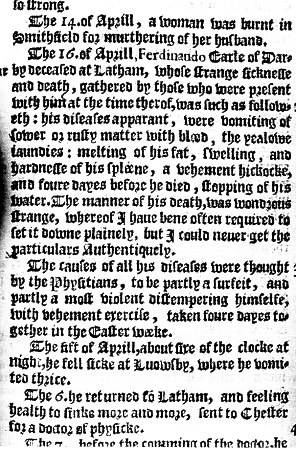
Figure 1: Frontispiece of Stow's Annales or a generall chronicle of England (1631)
Begun by John Stow, the book was continued by Edmund Howes.
(Original kindly provided by the London Library.)
[Originally in The Lancet Vol 357 June 9, 2001 and included here by kind permission of the author]
The unexpected death of Ferdinando Stanley, 5th Earl of Derby, on April 16, 1594 was an event of major political importance in the later years of Queen Elizabeth of England. When he had succeeded his father at the age of 38 he became head of one of the most influential families in the country. He also had a claim to the throne if Elizabeth died without naming a successor. Yet within seven months of entering into his inheritance, this previously fit man was suddenly taken ill and died a fortnight later. His death was so significant that the historian John Stow recorded his illness in great detail (figure 1).1 Stow's remarkable account is compatible with a sinister interpretation of the cause.

Figure 1: Frontispiece of Stow's Annales or a generall chronicle of England
(1631)
Begun by John Stow, the book was continued by Edmund Howes.
(Original kindly provided by the London Library.)
In the 14th century the Stanleys had been minor landowners in north-west England.2,3 However, their circumstances were considerably enhanced by Sir John Stanley, who pursued a successful military career under Edward III and Richard II. When Richard II was deposed and murdered by Henry IV, Stanley demonstrated the flexibility of loyalty which was a prerequisite for success at that time and continued to prosper, as did his son and grandson (the Ist Lord Stanley), in the service of whoever sat on the throne. It was his greatgrandson Thomas (figure 2) who was to perfect the art of always being on the winning side. The Wars of the Roses came to a climax when Henry of Richmond (whose claim to the throne was weak) defeated and killed Richard III at Bosworth Field in 1485, largely because the 2nd Lord Stanley decided not to join battle on the side of the king. Stanley was created Earl of Derby by the new king, Henry VII — who just happened to be the son of his second wife, Lady Margaret Beaufort. Lady Margaret chose not to live with her husband in his later years in Lancashire, but retired south to a more cultured existence. She used some of their vast wealth to found colleges at Oxford and Cambridge.

Figure 2: The Stanley and Derbys and their relationship to the crown of England
The 3rd Earl continued to demonstrate the family's pragmatism and successfully served Henry VIII (who established the Church of England), Edward VI, Mary Tudor (who restored Catholicism), and Elizabeth (Protestant). His lightness of political touch was reflected in the leniency, which, as Lord Lieutenant of Lancashire and Cheshire, he exercised towards whichever religious group was proscribed at the time. Under Elizabeth, he tolerated the many Catholics in Lancashire and since it was a time when anti-Spanish fears in England repeatedly reached fever pitch, it is not surprising that he was suspected of having strong Catholic sympathies. Nevertheless the family continued to prosper under the patronage of the queen and when the 4th Earl married the granddaughter of the younger sister of Henry VIII, it meant that their elder son, Ferdinando, would have a realistic claim to the throne (figure 2).

Figure3: Ferdinando, 5th Earl of Derby,
by Marcus Gheeraerts
Ferdinando (figure 3) lived his short life to the full. Married to the daughter of Sir John Spencer of Althorp in Northamptonshire, he distributed largesse and combined high living with ready patronage of the arts. He had his own troop of players, and there is circumstantial evidence that Shakespeare was among them; he certainly was after Ferdinando's death. Ferdinando's patronage might explain the arguably flattering portrait of the Stanleys in Shakespeare's Henry VI and Richard II, written in the early 1590s.
But on the very day that his father died in the autumn of 1593, Ferdinando received a visit from Richard Hesketh, a prominent Lancashire Catholic. He brought from a group of religious exiles (which included his father's cousin, William Stanley, and the Jesuit, Cardinal Allen in Rome) the suggestion that Ferdinando should promote his claim to the throne if Elizabeth died. However, the very idea was tantamount to high treason since Elizabeth jealously guarded her right to nominate her successor. The timing of the move was also unfortunate because it was just at the point when sufficient evidence had been gathered to apprehend the queen's physician, a Portuguese Jew named Roderigo Lopez (said to be the model for Shylock in Merchant of Venice) for conspiracy to poison her.
Ferdinando had to report the approach. Hesketh was executed but the episode did irreparable harm to the Derby family. There were those at court who were envious of their power and influence and who might have used this incident to emphasise that, no matter what Ferdinando claimed, the Catholic faction believed that they would prosper if he succeeded to the throne. They would also have been very aware of the events over the previous summer in France when the Huguenot leader, Prince Henri of Navarre, had emerged as victor from the prolonged Wars of Religion, but had then astonished his supporters by renouncing Protestantism and reverting to the Catholic faith before he assumed the throne as Henri IV. The capacity of the Stanley family for equally adroit flexibility in their allegiances would not have been forgotten and the possible parallels might well have been pointed out to Queen Elizabeth.
Before his illness, Ferdinando had been his usual vigorous self, and his company was no place for the fainthearted. He went hunting at Knowsley, in Lancashire, for four days in Easter week. Such "vehement exercise" was later judged by his physicians to have been a factor contributing to his death.1 However, at about 5 pm on April 5 he felt ill and vomited three times (figure 4). He moved the next day to his neighbouring estate, at Latham, near Ormskirk, and sent for a physician. On the second day of his illness, and before the doctor arrived, he vomited seven times. The vomit was described as "like soot or rusty iron and fatty". The total quantity was about 7 pints [more than 4 litres] and the smell was "not without offence". (For clarity the spelling in quotes from Stow's book has been modernised. The original style is illustrated in figure 4.) Two days later there was reference to his vomiting being complicated by continuous bleeding by mouth, and he is also said to have had yellow jaundice with "swelling and hardness of the spleen" and "melting of his fat". On the fifth day of his illness some spots appeared upon his sides and abdomen, and he began to suffer some abdominal pain. The physicians tried repeated purging in order to "draw the course of the humours downward". Stow calculates that during the 11 days of the earl's illness, "the number of his vomits were 52, and of his stools 29". However, the patient retained his mental faculties to the end, as illustrated by his sensible refusal to allow the physicians to draw blood and by his resistance to the suggestion that he should swallow some of his own vomit, "that thereby the bottom of his stomach might be scoured and cleansed from so vile and a loathsome matter wherewith he was troubled".

Figure 4: Extract from Stow's Annales in which he describes the start of Ferdinando's
illness
(Original kindly provided by the London Library.)
On the seventh day he suddenly developed anuria "to the astonishment of all". All means "were offered to provoke water". On the day before he died "an instrument called a Catheter, which being conveyed into his bladder, was strongly sucked by the surgeon but no water followed". Thus, he seems to have died from acute renal failure complicating jaundice and intractable vomiting. Acute renal failure might have been the result of volume depletion and circulatory collapse yet Stow records that until a quarter of an hour before he died "his pulse remained as good and perfect as ever it did in times of his best health". Indeed, Stow makes two references to this, so the evidence for circulatory collapse is not strong. His physicians suggested that "vehement exercise" or "surfeit" might have led to his death. If the latter refers to chronic alcohol abuse, cirrhosis with portal hypertension could explain the jaundice and enlarged spleen, and the "spots" may have been bruises. But while cirrhosis could have contributed to his illness, there is little else to suggest that this was primarily a case of fulminant hepatic failure. There was no coma, and the haematemesis came late and was not typical of bleeding varices. The predominant symptom throughout was vomiting, and this suggests an acute upper gastrointestinal disorder. Painless pancreatitis is a possibility, the splenomegaly possibly resulting from splenic-vein thrombosis. However, any other intra- abdominal emergency would very probably have been associated with marked pain and paralytic ileus, neither of which he had. Bacterial food poisoning is a possibility but there is no mention of anyone else being infected.
The physicians concluded that death was probably caused by witchcraft. The second part of Stow's account refers to disturbing dreams, strange coincidences, a ghost, and the appearance of an effigy in the chamber. He also describes a "homely woman" being allowed to stay for some days "mumbling in the corner of his honours chamber". When this woman was noted by one of the doctors to be "tempering and blessing (after her manner) the juice of certain herbs, her pot whereinto she strained the juice, was tumbled down by the said doctor, and she raced out of the chamber". It seems unlikely that any unknown mumbling woman would have been allowed to remain where she was and if she existed at all, she was probably a local "good wife" known to the family but whose presence irritated the professionals. The way in which this episode is related, and the details of the day-to-day account, suggest that Stow's principal informant was one of the doctors. The account ends by stressing that the earl himself believed he was bewitched and "cried out often against all witches and witchcraft reposing his only hope of salvation upon a mercy of Christ Jesus his Saviour". The heavy emphasis on witchcraft may indeed reflect the belief of the physicians, and of Stow, on the cause of the illness, since this would have been regarded as plausible at the time.4 Or could witchcraft have been highlighted to obscure another possibility?
Stow's account makes no reference to poison even though this was widely used in the 16th century to dispose of political and personal adversaries.5 Stow's chronicle refers several times to women being burnt at the stake for poisoning (usually their husband) (figure 4). So many opponents of Queen Elizabeth's erstwhile favourite, the Earl of Leicester, met untimely deaths that most were thought to have been poisoned, and they were said to have "caught Leicester's cold". Two of his supposed victims, the Earl of Essex and Sir Nicholas Throckmorton (or Throgmorton), died with severe gastrointestinal symptoms similar to those of Ferdinando. And since Ferdinando died only a month after Roderigo Lopez had been found guilty in a show trial of planning to poison the queen, the failure to consider poisoning is simply not credible.
The poisons most commonly used at the time were belladonna (atropine), nux vomica (strychnine), almond paste (cyanide), and distillations from aconite, hellebore, and henbane.5 However, these tend to cause death acutely and with predominant systemic, rather than gastrointestinal, manifestations. Poisoning with toxic fungi is possible, although dried extracts would have been necessary, given that the month was April. However, the clinical features are most compatible with acute poisoning with heavy metal, and the most likely candidate is arsenic. Arsenic is a severe gastrointestinal irritant and although abdominal pain is usual, it is not invariable. Moreover, arsenic causes multisystem failure, affecting both liver and kidneys, independent of volume depletion; and it also causes rashes. Certain characteristic symptoms of arsenic poisoning are not mentioned in Stow's account, such as irritation of the throat, and severe thirst. Since, however, Stow's omission of any reference to poisoning may have been deliberate, so too might the omission of symptoms known to be typical of it.
Two groups had a possible interest in the earl's death. The relatives of Richard Hesketh and their Catholic supporters were bitterly resentful at what was regarded as Ferdinando's betrayal. The 18th century chronicler, John Seacome, said that the earl had been earlier threatened: over the affair by "seditious and rebellious subjects".6 However, such retribution would not have been politically wise, given that it would involve the elimination of the person they hoped might champion their cause after Elizabeth's death. The other group with a motive were those who feared that Ferdinando's succession to the throne would herald a return to religious tolerance or, worse, reversion to Catholicism, as had happened in France the year before. The elimination of Ferdinando could have been seen as the only sure way to remove that possibility. He had no male heir, and his early death would result in a disputed inheritance which would reduce both the wealth and the influence of his successor to the title, and create a power vacuum from which others might benefit — which is, in fact, what happened 3 Ferdinando's death may have been natural but it is equally likely that he was murdered, and the existence of a group with a plausible motive makes this more probable than not. This possibility would have been even more apparent then than it is today, thus the details contained in (and, possibly, omitted from) Stow's contemporaneous account acquire great significance. Stow was a careful historian who was concerned with recording only what he felt to be verifiable fact, but he could suppress observation with which he was not in sympathy."7,8 He may have been hired on occasion to write propaganda for the Privy Council,9 and he could well have been influenced by the Protestant-dominated City institutions which supported him.8 Although Stow may once have had Catholic sympathies,10 he is unlikely to have omitted reference to poisoning through concern for Catholic dissidents in Lancashire. On the other hand, if it was widely suspected at the time that Ferdinando's death had been procured by people in high places, the emphasis placed on the (suspiciously abundant) evidence of witchcraft in Stow's account could well have been a deliberate attempt to deflect interest from the real cause of death. Stow may have been hinting at some external interference in his introductory sentence: "The manner of his death, was wondrous strange, whereof I have often been required to set it down plainly, but I could never get the particulars Authentically" (figure 4).
1 Stow J. Annales or a generall chronicle of England. London: Richard Meighen, 1631.
2 Coward B. The Stanleys: Lord Stanley and Earls of Derby 1385-1672. Manchester: Manchester University Press, 1983.
3 Bagley JJ. The Earls of Derby 1485-1985. London: Sidgwick & Jackson, 1985.
4 Sharpe J. Instruments of darkness: witchcraft in England 1550-1750. London: Penguin, 1997.
5 MacFall JEW. Buchanan's text-book of forensic medicine and toxicology, 9th edn. Edinburgh: E&S Livingstone, 1925.
6 Seacome J. The history of the House of Stanley. Manchester: J Cleave, 1821.
7 Manley L. Of sites and rites. In: Smith DL, Strier R, Bevington D, eds. The theatrical city. Cambridge: Cambridge University Press, 1995: 35-54.
8 Archer I. John Stow's survey of London. In: Smith DL, Strier R, Bevington D, eds. The theatrical city. Cambridge: Cambridge University Press, 1995: 17-34.
9 Smith Fussner F. The historical revolution. Westport, CT: Greenwood, 1976.
10 Dictionary of national biography. Oxford: Oxford University Press, 1997.
|
|
||
|
|
||
|
Any comments, errors or omissions
gratefully received The
Editor |
||